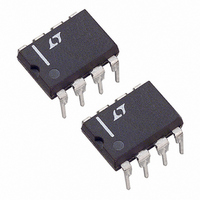LTC1044AIN8#PBF Linear Technology, LTC1044AIN8#PBF Datasheet - Page 5

LTC1044AIN8#PBF
Manufacturer Part Number
LTC1044AIN8#PBF
Description
IC CMOS VOLT CONV SW-CAP 8-DIP
Manufacturer
Linear Technology
Type
Step-Up (Boost), Switched Capacitor (Charge Pump), Divider, Doubler, Invertingr
Datasheet
1.LTC1044ACN8.pdf
(12 pages)
Specifications of LTC1044AIN8#PBF
Internal Switch(s)
Yes
Synchronous Rectifier
No
Number Of Outputs
1
Current - Output
20mA
Frequency - Switching
1kHz ~ 5kHz
Voltage - Input
1.5 ~ 12 V
Operating Temperature
-40°C ~ 85°C
Mounting Type
Through Hole
Package / Case
8-DIP (0.300", 7.62mm)
Lead Free Status / RoHS Status
Lead free / RoHS Compliant
Voltage - Output
-
Power - Output
-
TEST CIRCUIT
A
Rewriting in terms of voltage and impedance equivalence,
A new variable, R
= 1/(f C1). Thus, the equivalent circuit for the switched-
capacitor network is as shown in Figure 2.
Theory of Operation
To understand the theory of operation of the LTC1044A, a
review of a basic switched-capacitor building block is
helpful.
In Figure 1, when the switch is in the left position, capacitor
C1 will charge to voltage V1. The total charge on C1 will be
q1 = C1V1. The switch then moves to the right, discharg-
ing C1 to voltage V2. After this discharge time, the charge
on C1 is q2 = C1V2. Note that charge has been transferred
from the source, V1, to the output, V2. The amount of
charge transferred is:
If the switch is cycled f times per second, the charge
transfer per unit time (i.e., current) is:
PPLICATI
I = f
I =
q = q1 – q2 = C1(V1 – V2)
1/(f
V1 – V2
Figure 1. Switched-Capacitor Building Block
q = f C1(V1 – V2)
V1
C1)
O
EQUIV
=
V1 – V2
U
R
C1
f
EQUIV
S
, has been defined such that R
I FOR ATIO
U
+
C2
C1
10 F
W
1
2
3
4
R
LTC1044A • F01
L
LTC1044A
V2
LTC1044A • TC
U
8
7
6
5
EQUIV
C
OSC
Examination of Figure 3 shows that the LTC1044A has the
same switching action as the basic switched-capacitor
building block. With the addition of finite switch-on resis-
tance and output voltage ripple, the simple theory al-
though not exact, provides an intuitive feel for how the
device works.
For example, if you examine power conversion efficiency
as a function of frequency (see typical curve), this simple
theory will explain how the LTC1044A behaves. The loss,
and hence the efficiency, is set by the output impedance.
As frequency is decreased, the output impedance will
eventually be dominated by the 1/(f C1) term, and power
efficiency will drop. The typical curves for Power Effi-
ciency vs Frequency show this effect for various capacitor
values.
Note also that power efficiency decreases as frequency
goes up. This is caused by internal switching losses which
occur due to some finite charge being lost on each
switching cycle. This charge loss per unit cycle, when
multiplied by the switching frequency, becomes a current
loss. At high frequency this loss becomes significant and
the power efficiency starts to decrease.
EXTERNAL
OSCILLATOR
Figure 2. Switched-Capacitor Equivalent Circuit
V1
R
EQUIV
R
V
R
=
L
+
EQUIV
f C1
(5V)
+
1
C2
10 F
I
I
S
L
V
OUT
C2
R
L
LTC1044A
LTC1044A • F02
V2
5












